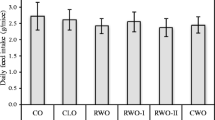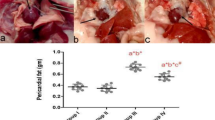Abstract
The byproduct of Salvia hispanica (chia) seed oil extraction by cold pressing, also known as expeller, possesses a high nutritional value. It is rich in proteins, fibers, minerals, and has a residual oil content of 7–11%, which is rich in omega 3 linolenic acid (ALA). However, this byproduct has been historically undervalued. Thus, the aim of current work was to study the effects of consuming of a rich in chia expeller diet on a rabbit model of metabolically unhealthy normal weight to validate their use as a functional food. Rabbits were fed different diets for a period of 6 weeks: a standard diet (CD), a high-fat diet (HFD), a rich in expeller CD (Exp-CD) and a rich in expeller HFD (Exp-HFD). The Exp-HFD attenuated the rise in basal glucose, TyG index, triglycerides, cholesterol and non-HDL cholesterol induced by the HFD. Both rich in expeller diets reduced mean arterial blood pressure (MAP) and increase liver and fat ALA levels compared to their respective controls. Furthermore, the angiotensin converting enzyme (ACE) activity was lower in the lungs of animals fed on rich in expeller diets compared to their respective controls. In vitro studies showed that ALA inhibited ACE activity. The evaluation of vascular reactivity revealed that rich in expeller diets improved angiotensin II affinity and reduced contractile response to noradrenaline. In conclusion, the consumption of rich in expeller diets showed beneficial effects in preventing cardiovascular risk factors such as insulin resistance, dyslipidemia and MAP. Therefore, its use as functional ingredient holds significant promise.



Similar content being viewed by others
Data Availability
No datasets were generated or analysed during the current study.
References
Bragança Ribeiro T, Bierhalz Voss G, Correia Coelho M, Estevez Pintado M (2022) Food waste and by-product valorization as an integrated approach with zero waste: future challenges. In: Rajeev Bhat (ed) Future Foods, Academic Press, pp 569–596. https://doi.org/10.1016/B978-0-323-91001-9.00017-7
Cotabarren J, Rosso A, Tellechea M, García-Pardo J, Rivera JL, Obregón WD, Parisi MG (2019) Adding value to the Chia (Salvia hispanica L.) expeller: production of bioactive peptides with antioxidant properties by enzymatic hydrolysis with Papain. Food Chem 274:848–856
Ozón B, Cotabarren J, Valicenti T, Parisi MG, Obregón WD (2022) Chia expeller: a promising source of antioxidant, antihypertensive and antithrombotic peptides produced by enzymatic hydrolysis with Alcalase and Flavourzyme. Food Chem. https://doi.org/10.1016/j.foodchem.2022.132185
Valdivia López MÁ, Tecante A (2015) Chia (Salvia hispanica): a review of native Mexican seed and its Nutritional and Functional properties. Adv Food Nutr Res 75:53–75
Martínez Cruz O, Paredes López O (2014) Phytochemical profile and nutraceutical potential of Chia seeds (Salvia hispanica L.) by ultra-high performance liquid chromatography. J Chromatogr A 1346:43–48
Ayerza R, Coates W (2011) Protein content, oil content and fatty acid profiles as potential criteria to determine the origin of commercially grown Chia (Salvia hispanica L). Ind Crops Prod 34:1366–1371. https://doi.org/10.1016/j.indcrop.2010.12.007016/bs.afnr.2015.06.002
Capitani M, Spotorno V, Nolasco S, Tomas M (2012) Physicochemical and functional characterization of byproducts from Chia (Salvia hispanica L.) seeds of Argentina. LWT Food Sci Technol 45:94–102
Coronel C, Corrales MP, Apezteguia J, Criscioni P (2019) Chemical composition and in vitro digestibility of Chia (Salvia hispánica L.) expeller. Compend Cienc Vet (Online) 9:7–10. https://doi.org/10.18004/compend.cienc.vet.2019.09.02.07
Coronel E, Guiotto E, Aspiroz M, Tomas M, Nolasco S, Capitani M (2021) Development of gluten-free premixes with buckwheat and Chia flours: application in a bread product. LWT Food Sci Technol 141:110916. https://doi.org/10.1016/j.lwt.2021.110916
Preda A, Carbone F, Tirandi A, Montecucco F, Liberale L (2023) Obesity phenotypes and cardiovascular risk: from pathophysiology to clinical management. Rev Endocr Metab Disord 24:901–919. https://doi.org/10.1007/s11154-023-09813-5
Franco LP, Morais CC, Cominetti C (2016) Normal-weight obesity syndrome: diagnosis, prevalence, and clinical implications. Nutr Rev 74:558–570. https://doi.org/10.1093/nutrit/nuw019
Batsis JA, Mackenzie TA, Lopez-Jimenez F, Bartels SJ (2016) Normal-weight obesity and disability in older adults: data from the national health and nutrition examination study 1999–2004. J Am Geriatr Soc 64:1367–1368
Konstantinidi M, Koutelidakis AE (2019) Functional foods and bioactive compounds: a review of its possible role on weight management and obesity’s metabolic consequences. https://doi.org/10.3390/medicines6030094. Medicines (Basel)
Khan SU, Lone AN, Khan MS, Virani SS, Blumenthal RS, Nasir K, Miller M, Michos ED, Ballantyne CM, Boden WE, Bhatt DL (2021) Effect of omega-3 fatty acids on cardiovascular outcomes: a systematic review and meta-analysis. https://doi.org/10.1016/j.eclinm.2021.100997. EClinicalMedicine
Aiassa V, Del Rosario Ferreira M, Villafañe N, Eugenia D’Alessandro M (2022) α-Linolenic acid rich-Chia seed modulates visceral adipose tissue collagen deposition, lipolytic enzymes expression, insulin signaling and GLUT-4 levels in a diet-induced adiposity rodent model. Food Res Int 156:111164. https://doi.org/10.1016/j.foodres.2022.111164
Chicco AG, D’Alessandro ME, Hein GJ, Oliva ME, Lombardo YB (2009) Dietary Chia seed (Salvia hispanica L.) rich in alpha-linolenic acid improves adiposity and normalises hypertriacylglycerolaemia and insulin resistance in dyslipaemic rats. Br J Nutr 101:41–50. https://doi.org/10.1017/S000711450899053X
Tamargo A, Martin D, Del Navarro J, Moreno-Arribas MV, Muñoz LA (2020) Intake of soluble fiber from Chia seed reduces bioaccessibility of lipids, cholesterol and glucose in the dynamic gastrointestinal model simgi®. Food Res Int 137:109364. https://doi.org/10.1016/j.foodres.2020.109364
Sierra L, Roco J, Alarcón G, Medina M, Van Nieuwenhove C, Peral M, Jerez S (2015) Dietary intervention with Salvia hispanica (Chia) oil improves vascular function in rabbits under hypercholesterolaemic conditions. J Func Foods 14:641–649
Alarcon G, Medina A, Martin Alzogaray F, Sierra L, Van Nieuwenhove C, Medina M, Jerez S (2020) Partial replacement of corn oil with Chia oil into a high fat diet produces either beneficial and deleterious effects on metabolic and vascular alterations in rabbits. https://doi.org/10.1016/j.phanu.2020.100218. Pharmanutrition
Alwosais EZM, Al-Ozairi E, Zafar TA, Alkandari S (2021) Chia seed (Salvia hispanica L.) supplementation to the diet of adults with type 2 diabetes improved systolic blood pressure: a randomized controlled trial. Nutr Health 27:181–189
Toscano LT, da Silva CS, Toscano LT, de Almeida AE, Santos Ada C, Silva AS (2014) Chia flour supplementation reduces blood pressure in hypertensive subjects. Plant Foods Hum Nutr 69:392–398. https://doi.org/10.1007/s11130-014-0452-7
Alarcon G, Roco J, Medina M, Medina A, Peral M, Jerez S (2018) High fat diet-induced metabolically obese and normal weight rabbit model shows early vascular dysfunction: mechanisms involved. Int J Obes (Lond) 42:1535–1543
Nair AB, Jacob S (2016) A simple practice guide for dose conversion between animals and human. J Basic Clin Pharm 7:27–31. https://doi.org/10.4103/0976-0105.177703
Poudyal H, Panchal SK, Waanders J, Ward L, Brown L (2012) Lipid redistribution by α-linolenic acid-rich Chia seed inhibits stearoyl-CoA desaturase-1 and induces cardiac and hepatic protection in diet-induced obese rats. J Nutr Biochem 23:153–162. https://doi.org/10.1016/j.jnutbio.2010.11.011
Oliva ME, Ferreira MDR, Vega Joubert MB, D’Alessandro ME (2021) Salvia hispanica L. (Chia) seed promotes body fat depletion and modulates adipocyte lipid handling in sucrose-rich diet-fed rats. Food Res Int. https://doi.org/10.1016/j.foodres.2020.109842
Fonte Faria T, Citelli M, Atella GC, Fonseca Raposo H, Zago L, de Souza T, Vargas da Silva S, Barja Fidalgo C (2019) Chia oil supplementation changes body composition and activates insulin signaling cascade in skeletal muscle tissue of obese animals. Nutrition 58:167–174. https://doi.org/10.1016/j.nut.2018.08.011
Gonçalves NB, Bannitz RF, Silva BR, Becari DD, Poloni C, Gomes PM, Foss MC, Foss-Freitas MC (2018) α-Linolenic acid prevents hepatic steatosis and improves glucose tolerance in mice fed a high-fat diet. Clin (Sao Paulo) 73:e150. https://doi.org/10.6061/clinics/2018/e150
Heskey CE, Jaceldo-Siegl K, Sabaté J, Fraser G, Rajaram S (2016) Adipose tissue α-linolenic acid is inversely associated with insulin resistance in adults. Am J Clin Nutr 103:1105–1110
van Deventer HE, Miller WG, Myers GL, Sakurabayashi I, Bachmann LM, Caudill SP, Dziekonski A, Edwards S, Kimberly MM, Korzun WJ, Leary ET, Nakajima K, Nakamura M, Shamburek RD, Vetrovec GW, Warnick GR, Remaley AT (2011) Non-HDL cholesterol shows improved accuracy for cardiovascular risk score classification compared to direct or calculated LDL cholesterol in a dyslipidemic population. Clin Chem 57:490–501. https://doi.org/10.1373/clinchem.2010.154773
Alarcon G, Sierra L, Roco J, Van Nieuwenhove C, Medina A, Medina M, Jerez S (2023) Effects of Cold pressed Chia seed oil intake on hematological and biochemical biomarkers in both normal and hypercholesterolemic rabbits. Plant Foods Hum Nutr 78:179–185. https://doi.org/10.1007/s11130-022-01036-4
Zhao G, Etherton TD, Martin KR, West SG, Gillies PJ, Kris-Etherton PM (2004) Dietary α-Linolenic acid reduces inflammatory and lipid cardiovascular risk factors in hypercholesterolemic men and women. J Nutr 134:2991–2997. https://doi.org/10.1093/jn/134.11.2991
Alexander Aguilera A, Berruezo S, Hernández Diaz G, Angulo O, Oliart Ros R (2011) Dietary n-3 polyunsaturated fatty acids modify fatty acid composition in hepatic and abdominal adipose tissue of sucrose-induced obese rats. J Physiol Biochem 67:595–604. https://doi.org/10.1007/s13105-011-0106-2
San Pablo Osorio B, Mojica L, Urías Silvas JE (2019) Chia seed (Salvia hispanica L.) Pepsin Hydrolysates inhibit angiotensin-converting enzyme by interacting with its catalytic site. J Food Sci 84:1170–1179. https://doi.org/10.1111/1750-3841.14503
Ogawa A, Suzuki Y, Aoyama T, Takeuchi H (2009) Dietary alpha-linolenic acid inhibits angiotensin-converting enzyme activity and mRNA expression levels in the aorta of spontaneously hypertensive rats. J Oleo Sci 58:355–360. https://doi.org/10.5650/jos.58.355
Lembo G, Iaccarino G, Rendina V, Volpe M, Trimarco B (1994) Insulin blunts sympathetic vasoconstriction through the α2-Adrenergic pathway in humans. Hypertension 24:429–438
Acknowledgements
The authors thank Agustina Gonzalez Colombres for technical support.
Funding
This research was supported by: PICT 2015/1164 (ANCyT-Argentina); PIUNT G728 (SCAIT, Argentina), and by institutional funds from Instituto Superior de Investigaciones Biológicas (INSIBIO).
Author information
Authors and Affiliations
Contributions
All authors contributed to the study conception and design. Material preparation, data collection and analysis were equally performed by Gabriela Alarcón and Agostina Valoy. Florencia Martin Alzogaray, Analia Medina, Carina Van Nieuwenhove and Mirta Medina participated of data collection. The first draft of the manuscript was written by Susana Jerez and all authors commented on previous versions of the manuscript. All authors read and approved the final manuscript.
Corresponding author
Ethics declarations
Compliance with Ethical Standards
All experimental protocols were approved by the Institutional Animal Ethics Committee (CICUAL from the National University of Tucuman, Argentina-Approval number: 021/2019; Date: November 15th, 2019; Date endorsed: March 23th, 2021) according to the Guide for the Care and Use of Laboratory Animals (NIH Publication 8th edition, updated 2011).
Conflict of Interest
The authors have no competing interests to declare.
Consent to Participate
not applicable.
Consent for Publication
not applicable.
Additional information
Publisher’s Note
Springer Nature remains neutral with regard to jurisdictional claims in published maps and institutional affiliations.
Electronic Supplementary Material
Below is the link to the electronic supplementary material.
Rights and permissions
Springer Nature or its licensor (e.g. a society or other partner) holds exclusive rights to this article under a publishing agreement with the author(s) or other rightsholder(s); author self-archiving of the accepted manuscript version of this article is solely governed by the terms of such publishing agreement and applicable law.
About this article
Cite this article
Alarcón, G., Valoy, A., Alzogaray, F.M. et al. Consumption of a Byproduct of Chia Seed Oil Extraction by Cold Pressing Ameliorates Cardiovascular Risks Factors in an Experimental Model of Metabolically Unhealthy Normal Weight. Plant Foods Hum Nutr 79, 292–299 (2024). https://doi.org/10.1007/s11130-024-01193-8
Accepted:
Published:
Issue Date:
DOI: https://doi.org/10.1007/s11130-024-01193-8




